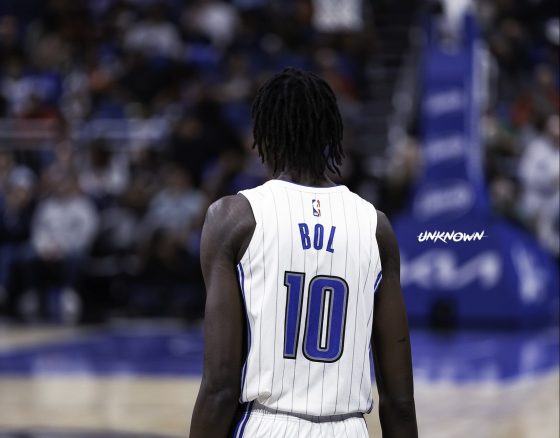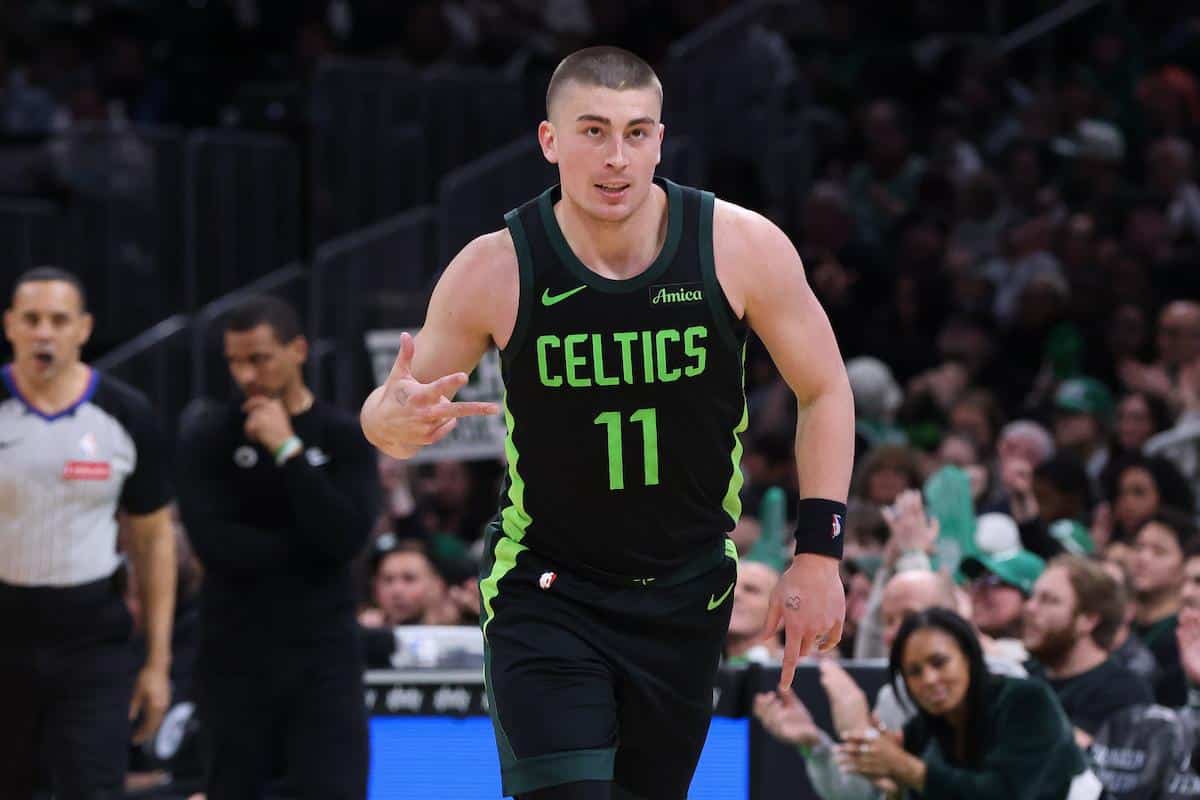Let’s start off with a piece of highly confidential information that you probably are not aware of: head coach Joe Mazzulla likes three-point shooting. We often want what we can’t have and the man with a 29.3% career shooting percentage from 3 in his collegiate career is now basing his coaching philosophy around it.
Given that it will be a foundation of the team, it begs a very important question: will the Celtics be able to maintain their elite three-point shooting next year?
Leaning into a three-point heavy attack makes sense with a team that makes them, less so with one that doesn’t. Last year, the math was in their favor. They were the 6th most accurate deep shooting team and took the second most, only behind the team that employs two of the greatest shooters of all time. No, not the Heat, although it felt like Gabe Vincent and Caleb Martin were Steph and Klay in the Eastern Conference Finals. The result was the Celtics ending with the 4th best offense in the league per Cleaning the Glass and the 2nd best per NBA.com.
By basically any measure, the Celtics were elite from three last season, or as the kids might say they, were bussin’ (I heard my 9-year-old nephew describe something good in this manner, so I’m rolling with it). Lots of attempts at a good percentage drives efficient offense, and it worked last season. But in the words of Samuel L. Jackson in Jurassic Park, “hold on to your butts.” There’s some reason to be concerned it won’t yield the same results in the upcoming season.
The Celtics will almost certainly be at the top of the league in three point attempts next year, but will they be similarly efficient? We’re going first take a look at the players who are due for some negative regression next season, and there’s quite a few. Then we’ll take a look at the players that might be due for some positive regression before ending with a discussion on the roster turnover and how that might affect shooting.
Just a bit on the method here. Instead of looking at overall 3-point shooting, I’m going to look at open and wide-open shots. There’s less variables affecting those shots and the sample sizes are much large. Whereas covered shots are prone to all sorts of randomness and generally have much smaller sample sizes (please shoot fewer contested threes, Jayson Tatum). Additionally, we are going to look at the 2020-21 and 2021-22 seasons and compare that to how they shot open and wide open 3s in 2022-23.
The negative regression candidates
First, allow me to present you with the first of three extremely high quality and beautiful charts I’ve made for this piece.
Al Horford has the highest bump in open three-point shooting from the previous two seasons, but Brogdon might be the most interesting. Brogdon’s primary value is his ability to score efficiently off the bench, and his efficiency is pretty one-dimensional. Brogdon was one of the worst high volume rim finishers in the league last year, and while he was ok from mid-range, it’s an inefficient shot and was on a relatively low volume. His elite free throw shooting helps, but even with his ridiculous outside shooting, he was an above-average, not quite elite 61.5 TS%. If his outside shooting drops to even the high 30s, Brogdon will go from above average efficiency to below average efficiency, and that can really impact his value to the team. Couple that with his forearm injury impacting his shot, and we might see some painful regression from Brogdon next season.
With that said, Brogdon’s three-point shooting numbers are an anomaly wrapped in a paradox. He essentially flip flops between elite and below average every other year. Here are his 3pt percentages from his last five years in the league: 42.6%, 32.6%, 38.8%, 31.2%, 44.4%. Maybe Brogdon can buck that trend like he did his first three years in the league, or perhaps we should prepare for Malcolm Brogdon to turn into Russell Westbrook from three next year. Let’s hope not.
:no_upscale()/cdn.vox-cdn.com/uploads/chorus_asset/file/24855591/1472889641.jpg)
Photo by Kevin C. Cox/Getty Images
Horford is almost certainly going to slip a bit on his open shot-making. I doubt he will tumble to the painful depths we saw in the playoffs, but I expect him to settle back into a very acceptable high 30s on open threes. This will have some impact on the Celtics’ shooting as a whole and given that Al is geriatric in basketball years, his minutes and shot attempts should drop, which limits how much his regressed percentage will impact the team’s overall shooting.
The shooting bump from White was very nice, and if any of this trio reject regression, it will be Derrick. He clearly spent time in the gym and his shot looked cleaner up top and much more on balance on bottom. The result was a legitimate and hopefully sustainable shooting bump on open and wide-open threes.
Overall, I think it’s likely we see a noticeable dip in open shot efficiency from Brogdon and Horford, and perhaps a slight one from White. Given that those three accounted for 297, 325, and 391 threes last season respectively, even a few percentage points here and there could have a legitimate impact on the Celtics as a shooting team overall.
The positive regression candidates
For this second chart, I asked my friend who works at Disney to hook me up with one of the animators for Star Wars. As you can see, things went great.
:no_upscale()/cdn.vox-cdn.com/uploads/chorus_asset/file/24854740/Second_Picture.jpg)
This chart is a lot more fun to analyze, but perhaps a bit less encouraging than the previous is discouraging. Jaylen Brown’s open shooting is strange. You’d think as he aged, got more confident in the jumper both at the line and mid-range, the three would follow right along with it. It hasn’t, but with the addition of Kristaps Porzingis, you have to think Jaylen will get the most open threes of his career, and I anticipate that percentage will climb at least to its previous heights. If he can exceed that 37.9% number, then we are really in business.
:no_upscale()/cdn.vox-cdn.com/uploads/chorus_asset/file/24855598/1239380993.jpg)
Photo by Bart Young/NBAE via Getty Images
Payton Pritchard has proven he’s an elite three-point shooter his entire career, and I anticipate last year was an anomaly partially brought on by inconsistent playing time. That’s a pretty massive drop for a shooter of his ilk, a drop off that likely will not be a trend. He should also benefit from a lot of open catch-and-shoot threes, where he was considerably more accurate last year, with the arrival of KP and playing off Tatum in bench lineups.
If you get the bump from Jaylen Brown in both open attempts and percentage back up to around 38%, and you add PP regaining his efficiency while playing more and attempting more shots (he only took 142 open threes last year), that goes a long way to balancing out the likely regression from Brogdon, Horford, and (maybe) White.
The really tall guy, the Candian wing, and who they replaced
While the returning roster certainly has some shooting uncertainties (which is what I call the weird pains I get along my shoulder blades) going into this next season, the new faces replacing beloved Celtic Marcus Smart and also Grant Williams aren’t all positive on the shooting front either. It’s probable Porzingis, like Smart, will be a high minute contributor while Oshae Brissett will probably absorb a minute load fairly close to Grant Wiliams (or split between him and Sam Hauser). But is that a shooting upgrade? First, let’s look at what we can expect from Porzingis and Brissett in my final extremely artistic chart.
:no_upscale()/cdn.vox-cdn.com/uploads/chorus_asset/file/24854833/Third_Picture.jpg)
These are some Barbara-Eden-and-John-Forsythe-opposites-attract style numbers. KP was way above his head shooting open threes last year while Brissett fell off the cliff so hard it would make Wile E. Coyote cringe. You’d imagine Porzingis is probably going to see some negative regression while we hope Brissett sees some sizeable positive. Let’s say they land around 37% and 35% on 325 and 225 open or wide-open threes respectively (deflating Porzingis’ attempts with the assumption he will miss some time with injury). How does that compare to the production of Smart and Williams last year?
Smart shot 106-of-310 on open threes, good for 34.2%, and Grant shot 111-of-277 good for 40.1%. Combined, that means they shot 37.0% on 587 open or wide-open threes last season. In short, it’s pretty unlikely that Porzingis and Brissett will significantly improve on that production. Grant Williams, who is likely due for some regression himself, is carrying a lot of water here, but his offensive contribution of making a whole bunch of open shots at a high-ish frequency has value. This is especially true in an offense that prioritizes spacing and taking open threes.
The hope is that while Porzingis and Brissett may not be as efficient from three as Smart and Williams combined, KP replaces Smart’s high-volume shooting with more efficient high-volume shooting. Meanwhile, some combination of Brissett and Hauser will mostly replace Grant’s shooting, but also provide a more diverse and mature skill set defensively (Brissett) and/or offensively (Hauser and maybe Brissett). If it’s Hauser getting the nod, his catch-and-shoot numbers (42.7% on 3.8 attempts per game) and percentages on open to wide open looks (41.2% on 274 attempts) could be key component to the second unit.
On balance, it looks like the Celtics have more players poised for some negative regression than positive, and despite turning Smart into Porzingis, they are probably losing some three-point shot making through roster moves. From everything we’ve seen of Joe Mazzulla, I don’t think he cares. I have a hard time seeing Joe adjusting his approach on that end just because the team might be slightly worse from three overall, which they very likely will be.






